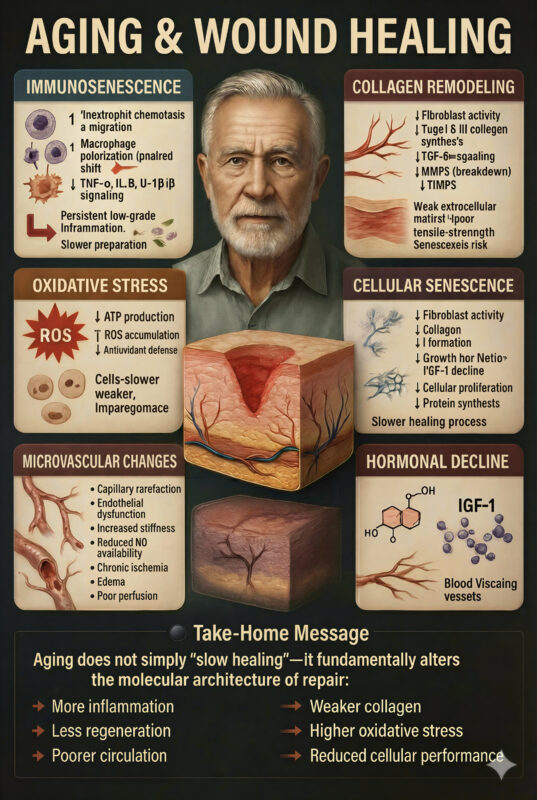
Mohamed Magdy Badr – Aging and Wound Healing: Why Older Adults Heal Differently ?
Mohamed Magdy Badr, Wound Care Consultant at Armed Force Rehabilitation Center, posted on LinkedIn:
”Aging and Wound Healing: Why Older Adults Heal Differently – A Molecular Perspective
Wound healing doesn’t stop with aging…
It becomes molecularly inefficient.
Every phase – immunity, angiogenesis, collagen remodeling, cellular regeneration—becomes slower, weaker, and more vulnerable to complications.
As clinicians, understanding these mechanisms transforms how we manage wounds in older adults.
1. Immunosenescence: When Immunity Ages
Aging reshapes the inflammatory phase:
↓ Neutrophil chemotaxis and migration
↓ Macrophage M1→M2 transition → prolonged inflammation
↓ TNF-α, IL-6, IL-1β signaling
↑ Biofilm susceptibility
Clinical result: slow wound bed preparation, chronic inflammation, higher infection risk.
2. Stem Cell Exhaustion and Cellular Senescence
Senescent cells accumulate and stop participating in repair:
↓ Fibroblast and keratinocyte proliferation
↓ Epidermal stem cell reservoir
↑ SASP → persistent low-grade inflammation
↓ Telomerase activity
Outcome: delayed epithelialization, fragile wound edges, thin and easily damaged skin.
3. Impaired Angiogenesis
Microvascular growth becomes inefficient:
↓ VEGF expression
↓ HIF-1α stability
↓ Endothelial responsiveness
Capillary rarefaction
Outcome: ischemic wound bed, necrosis risk, delayed granulation.
4. Collagen Remodeling Defects
Structural repair becomes weak:
↓ Type I and III collagen
↓ TGF-β signaling
↑ MMPs / ↓ TIMPs
Outcome: weak ECM, poor tensile strength, higher risk of dehiscence.
5. Oxidative Stress and Mitochondrial Decline
A key hallmark of aging:
↓ ATP → slower cell migration
↑ ROS → DNA and protein damage
↓ Antioxidant defenses
Outcome: sluggish fibroblasts, poor angiogenesis, weak repair.
6. Microvascular and Endothelial Changes
Endothelial dysfunction
↓ Nitric oxide
Vascular stiffness
Capillary loss
Outcome: chronic ischemia, edema, slower healing.
7. Hormonal Decline
Estrogen deficiency:
↓ Collagen synthesis, ↓ keratinocyte migration, ↑ inflammation
GH and IGF-1 decline:
↓ Cell proliferation, ↓ protein synthesis
8. Comorbidities Multiply the Burden
Diabetes → AGEs, impaired immunity, microangiopathy
Kidney disease → uremic endothelial dysfunction
Heart failure → hypoperfusion
Steroids and anticoagulants → repair inhibition and bleeding issues
Key Insight
Aging doesn’t merely “slow healing”—
It reprograms the molecular architecture of tissue repair, leading to:
- More inflammation
- Less regeneration
- Poorer circulation
- Weaker collagen
- Higher oxidative stress
- Reduced cellular performance
To optimize outcomes, wound care in older adults must be personalized, biology-driven, and risk-stratified.”

Stay updated with Hemostasis Today.
-
Nov 27, 2025, 16:00Nathan Connell on WFH AI Summaries from the Global Forum
-
Nov 27, 2025, 15:49Piotr Czempik: Rethinking Coagulation in Acute Liver Dysfunction
-
Nov 27, 2025, 15:35Overwhelmed? A Leader’s Guide from Mark Crowther to Getting Back on Track
-
Nov 27, 2025, 15:10Wolfgang Miesbach’s Top 10 Picks for TTP and Thrombosis from ASH 2025
-
Nov 27, 2025, 14:24ICCBBA’s Executive Director Eoin McGrath Chairs a Dynamic Session on AI, Innovation and Informatics in Transfusion Medicine
-
Nov 27, 2025, 13:26Wolfgang Miesbach’s Top 10 Picks for Bleeding Disorders from ASH 2025
-
Nov 27, 2025, 11:19Priya Prasad Presents a Case of Severe Hypotensive Transfusion Reaction
-
Nov 27, 2025, 04:07Eugene Tang Presents Highlights from UK Stroke Forum 2025
-
Nov 27, 2025, 03:47Michael Makris: I Believe the Time Has Come to Consider Emicizumab Up Front in Persons with Acquired Hemophilia
